Basement ventilation in a private house: optimal ways to arrange proper air exchange
Basement ventilation, like ventilation of any living space, is necessary to ensure that exhaust air is replaced with fresh air. Thanks to organized air exchange, the cellar or basement becomes suitable for use as a pantry, storage for vegetables or fruits.
If you take the improvement of the basement more seriously, then in this area you can place a swimming pool, garage or home gym. However, basement ventilation in a private house has its own characteristics. We will talk about them in more detail in our article. We will analyze the rules for arranging ventilation in the basement with natural air exchange, as well as in the case of using forced ventilation.
The content of the article:
Features of creating a residential microclimate
There are many reasons to install a complete, properly functioning basement ventilation system. They concern both the preservation of the building structure and the provision of a favorable atmosphere for living.
Stagnation of air masses and lack of ventilation lead to the fact that fungus and mold affect all objects in the room - from things and products to walls and foundations.

To create a comfortable microclimate in the cottage, it is important that cellar, and the attic, and all other technical and living spaces were equipped with a ventilation system. Therefore, methods for its construction are thought out during planning, when a house project is being drawn up.
Among the most rational techniques is the arrangement of supply and exhaust ducts, as well as openings in the walls, providing a natural change of air.
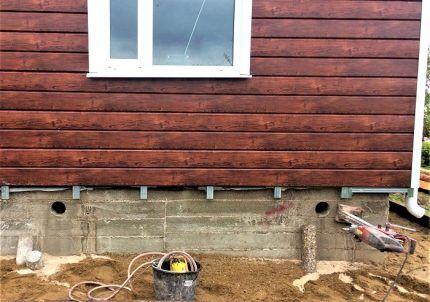
If you do not take into account the installation of special electrical equipment, the ventilation system is based on the well-known laws of physics: heated air rises up and leaves the room through a pipe, and cold air enters, replacing it, through a second pipe.
The two-pipe air exchange system is based on this principle.
A simpler option with one pipe is also used - when fresh air enters through holes in the wall or foundation and exits through an upward-directed line.
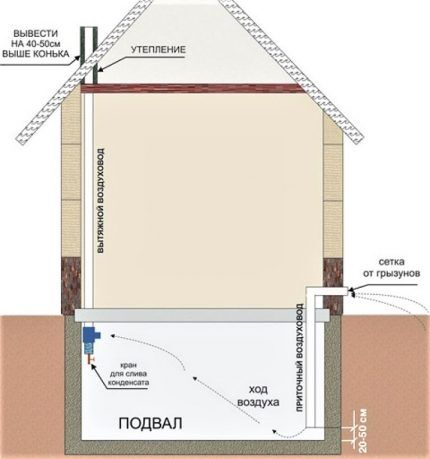
When installing any system using ventilation pipes It is important where to organize the air intake and at what height the channels should be installed. The length and diameter of the pipes are also calculated so that the ventilation system works with maximum effect.
Types of basement ventilation
Basement ventilation systems in private households are classified according to general principles.For example, depending on the way the pressure of the moving air is organized, they can be natural or forced.
Let's consider the features of both types, since design differences affect the choice of materials and installation method.
Option #1 - natural air exchange
To organize the circulation of air masses without connecting additional equipment, it is necessary to create conditions under which air exchange would occur only due to the difference in pressure and temperature. This is a variant of supply and exhaust ventilation typical for residential premises.
The principle of operation is simple: the cellar space is filled with cold air from the street, entering through the supply openings and pipes, and the waste medium is discharged through the exhaust duct.
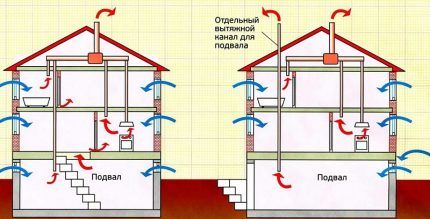
The advantages of a natural ventilation device are ease of installation and low costs for purchasing components. You can purchase pipes and install them yourself.
The simple-to-use natural circulation system also has its disadvantages. The main one is dependence on external factors. The quality of air exchange may be affected by sudden changes in temperature or pressure, as well as by atmospheric phenomena such as strong wind or prolonged rain.
It is better to start designing a natural system in advance, before the walls are erected. You need to select pipes of the required cross-section and think about their location.
Exactly what elements will be required to equip a basement ventilation system can only be determined after analyzing the design of a particular basement.However, there are components that can be called universal:
A few installation recommendations:
- The exhaust duct is positioned as high as possible. Traditionally, it leads from the basement ceiling to the roof of the building and extends approximately 0.5-0.6 m above the roof covering.
- The hood is installed along the outer wall or parallel to one of the main walls, if other rooms are connected to it, for example, bathrooms.
- The supply pipe is installed above the cement base or basement flooring, at a height of 0.3-0.4 m, its second end is brought out above the ground surface.
- The average diameter of pipes and boxes is 120-150 mm, for large basements, products up to 200 mm are used.
If you break the basic rules, problems can arise.For example, if the end of the exhaust pipe is lowered at least 0.2-0.3 m below the ceiling level, then dampness will appear in the room - stagnation of air under the ceiling will lead to the appearance of mold.
Option #2 - forced ventilation
Many people decide to install a natural ventilation system for their basement and do not think about the fact that it loses efficiency due to natural factors.
More prudent building owners go further - they complement the design with forced air circulation devices. Simply put, they are installed in pipes fans.
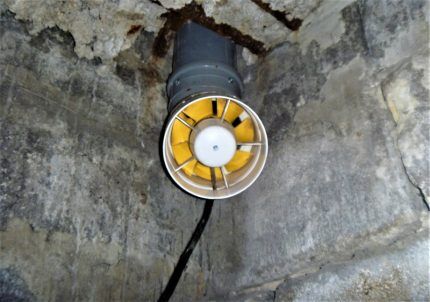
How to determine that there is a need to install additional equipment? If, coming from the street or from a living space, you feel a lack of fresh air and try to ventilate the basement, natural ventilation cannot cope.
If there is a living space in the basement or basement, there may be a problem with the flow of too cold air through the supply units, especially in winter.
In order for already heated air masses to enter inside, they install heater or air conditioner. In addition, the system is equipped with additional sound insulation and high-quality air filters.
Which ventilation is better to choose? It is believed that the most appropriate is a combined method, when, if natural circulation is insufficiently effective, forced circulation can be used.

Typically, fans and other devices “rest” in the off-season, when air exchange occurs due to differences in temperature and pressure.
In cold weather, it is often necessary to close the air supply units because the temperature of the incoming air is too low, and in the summer, use fans or air conditioners.
Air duct installation rules
There is no universal scheme for arranging a ventilation system - it all depends on the volume of the room, the design of the building as a whole, climatic conditions and even the material from which the house is built.
Therefore, we will consider general rules that may be useful when installing ventilation ducts.
Features of planning and calculations
Important points are to correctly calculate the dimensions of the components and choose the location for their installation.
To equip a cottage intended for permanent residence, it is better to draw up project forced ventilation system. It can work autonomously and does not depend on natural factors.
For installation you will need:
- pipes for installing exhaust and supply channels;
- fans or other blowing units;
- air intake for the supply channel;
- deflector or a canopy for the exhaust duct;
- diffusers, tees and adapters for connecting pipes.
Asbestos-cement pipes are used less and less due to their fragility, transportation and installation features. But they don't need to be insulated and are relatively inexpensive.
Much more often used plastic and galvanized steel products. The former are distinguished by ease of processing and low weight, the latter by strength and long service life.
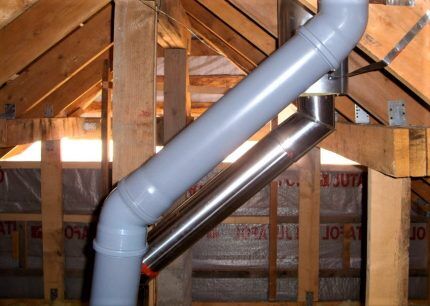
How to determine the diameter of the channels? To arrange a large garage, swimming pool or basement guest room, it is better to invite specialists who use a complex calculation algorithm that takes into account all factors.
But to install a ventilation system in a small basement of a private house, you can use a universal calculation scheme.
Let's assume that you need air ducts for a small basement with an area of 10 m². We multiply this number by the average coefficient - it is assumed that for each square. meter of area required 26 cm² pipe cross-sectional area: 10 x 26 = 260 cm².
Then we find the radius using the formula: R = √ (T / π): √ (260: 3.14) = 9.1.
Multiply the radius by 2 to get the internal diameter: 9.1 x 2 = 18.2 cm.
Therefore, the recommended pipe diameter for the air duct is approximately 18 cm.
You can also use tables provided by duct manufacturers or tools that perform online calculations. The results will be more accurate.
Recommendations for equipment installation
Let's assume that the basement in the house is already equipped or is under construction. The order of installation of the exhaust and supply lines is not important.
You need to make a hole in the ceiling for the pipe, taking into account the fact that it will go higher - either through living quarters, or along the street, near the wall, but in an insulated version. Most often this is a place in a corner, near a chimney or an insulated wall.
We recommend that you read construction rules ventilation passage through the roof.
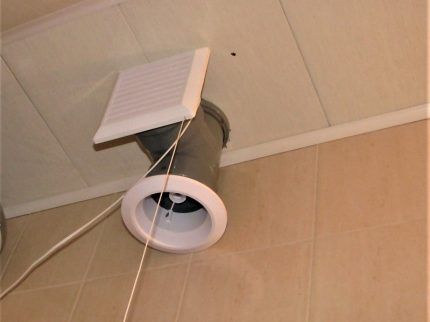
The channel is installed above the roof at least 0.6 m, but sometimes the height of the section above the roof surface reaches 1.5 m. The upper part is equipped with a canopy to prevent debris and moisture from entering the channel. If you also install a deflector, you can count on an increase in traction.
Due to the temperature difference, moisture will settle on the inner walls of the pipe, so a condensate collector is installed in the lower part, which must be emptied periodically if the water does not evaporate naturally.
Then they proceed to the installation of the supply main. A second pipe is fixed in the opposite corner or against the wall. Its end should be as close to the floor as possible - preferably at a distance of 0.2-0.4 m.
Through a hole in the foundation, the pipe is led out into the street and raised above the surface. The upper part is equipped with a grill or mesh.
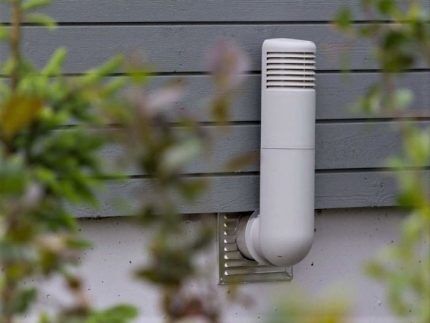
If you are not lazy and install simple devices on the pipes - dampers, then the air flow can be regulated.
To create a simple forced system, fans are installed on both pipes. On sale you can find household appliances designed for different diameters of pipes with round and rectangular cross-sections.
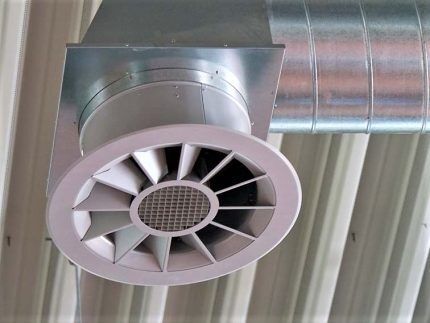
After installing the system, it needs to be tested. To do this, use a simple “grandmother’s” method - bring a sheet of paper to the exhaust hole. With good traction, it “sticks” to the grate.
Instead of a sheet, you can use a lit match - by the inclination of the flame, you can judge the effectiveness of the hood.
It is not practical to install a single pipe system or other inferior ventilation options. Supply and exhaust ventilation with two types of air ducts and forced circulation elements is recognized as the most rational and simplest to implement.
Conclusions and useful video on the topic
The use of automation in amateur performance:
User's opinion about forced ventilation:
Which pipes are best suited for basement ventilation:
If a house is being built by experienced builders, then even when laying the foundation they worry about ventilation in the basement. It is much easier to install the system in prepared walls and ceilings.
However, do not despair if the house has already been built and the ventilation is not working well - you can always find a way to improve its efficiency.
Do you still have questions about arranging ventilation in the basement? Ask them under this article - our experts and other site visitors will try to help you.
If you want to share your experience of making your own ventilation system equipment, tell us about it in the comments block.




A dry and well-ventilated basement is the key to the absence or at least a noticeable reduction in the formation of condensation, and with it mold and other harmful microorganisms.Unfortunately, natural ventilation does not always cope with its task. Another thing is the forced air exchange system. It’s not particularly difficult to build, and the “exhaust” will be significant - you can safely store food without fear of rot, mold, etc.
For a long time, in my basement there was only ventilation through a pipe vented to the outside. Passive, as it is also called. Better than nothing, but dampness and all sorts of odors were always present in the basement, even in the hottest summer. Then the son performed forced ventilation. It is impossible to say that now there is not a single smell, but it has become much better. At least the walls are now condensation-free all year round.
At the dacha in the basement there is one supply and exhaust hole each, but condensation still accumulates. Either the diameter is small or something else. Should installing a duct fan help? And where is it better to bet - on the entrance or on the exit?
It may not be a ventilation issue. It is possible that you need to insulate and waterproof the enclosing structures (outside). If everything is in order with this, then feel free to make a good ventilation system, then condensation will not form.
My cellar is located in the garage and the ventilation diagram looks like this (I attach a photo). I recommend using dampers on the supply valve (see photo), with which you can regulate the speed of air flow through the cellar.
If there is only one fan, then it is better to put it on the hood and it is not necessary to do this in the basement-cellar. It is better to place it on the hood and at the top of the pipe.